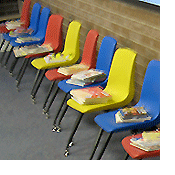 Last week was our Read to the Dogs / Crafty Saturday program. Towards the end, I noticed that a little girl had removed all the child-sized chairs from the small tables and had carefully lined them all up against the wall. Then she proceeded to place a stack of board books on each chair. She was bustling about up and down the row of chairs, moving the books around, rapt in her own make-believe world.
Last week was our Read to the Dogs / Crafty Saturday program. Towards the end, I noticed that a little girl had removed all the child-sized chairs from the small tables and had carefully lined them all up against the wall. Then she proceeded to place a stack of board books on each chair. She was bustling about up and down the row of chairs, moving the books around, rapt in her own make-believe world.
Earlier in the week, I had seen an older child doing much the same thing, except she had taken all the stuffed animals and seated them in the chairs at the tables and was singing to them as she supervised their work.
In this out-of-the-way corner of the large children’s room, with its child-sized tables and chairs arranged next to child-height shelving, kids have discovered a perfect space for creating their own worlds. I’m glad that our library includes space for creative play. Recently I read Susan Linn’s new book, The Case for Make Believe: Saving Play in a Commercialized World. Linn, who is a psychologist, therapist, scholar, and puppeteer, points to the rise of toys and craft kits that encourage kids to replicate someone else’s design rather than creating their own.
A few years ago I was working at an university library and helping a lot of undergraduate students each semester who were in a state of panic over an assignment to go to the art museum and describe a work of art in their own words. They inevitably ran to the library and begged the librarian to find a printed description of the work in question. No amount of pointing out that the assignment clearly stated that they were to describe the work themselves, in their own words, would satisfy them. They had no confidence at all in their own ability to look, see, and describe. Was this a result of our society’s persistence in viewing the arts as unnecessary frills, and the withdrawal of funding for arts education? I wondered if this could be somehow related to the whole cult of perfection that seemed to have destroyed a lot of individual music-making. With the perfection of music created in a recording studio, people seemed to find their own performances too flawed and imperfect and just gave up making music altogether.
When I inherited the Friday story-time at my library, which included a craft, I didn’t realize at first that the “craft” had previously consisted of coloring printed coloring pages. Since I was looking at the project from my perspective as a college instruction librarian who had done a lot of reading and thinking about pedagogy, I wanted to create crafts that would build on the story and provide avenues for creative dramatic play around the story theme. The transition from coloring pre-printed pages to putting together somewhat complex crafts was harder on the parents than on the kids, I suspect. I noticed that, at first, I needed to create very prescribed kits. Over time, I have done less and less pre-processing and have left more leeway for adapting and personalizing the project. Occasionally I throw in a very open-ended project.
It has been thrilling to see how self-sufficient and creative the kids have become! I know I have succeeded when I see the kids playing with their personalized version of the craft project in ways that show that they are inhabiting the world of the story and making up their own dramatic variations. A number of parents and grandparents have described how their kids continue this dramatic play at home. Others have thanked me for making the process of creation a big part of the fun, with less focus on the end product.
It’s important to preserve and create spaces for creativity, both physically and temporally.

